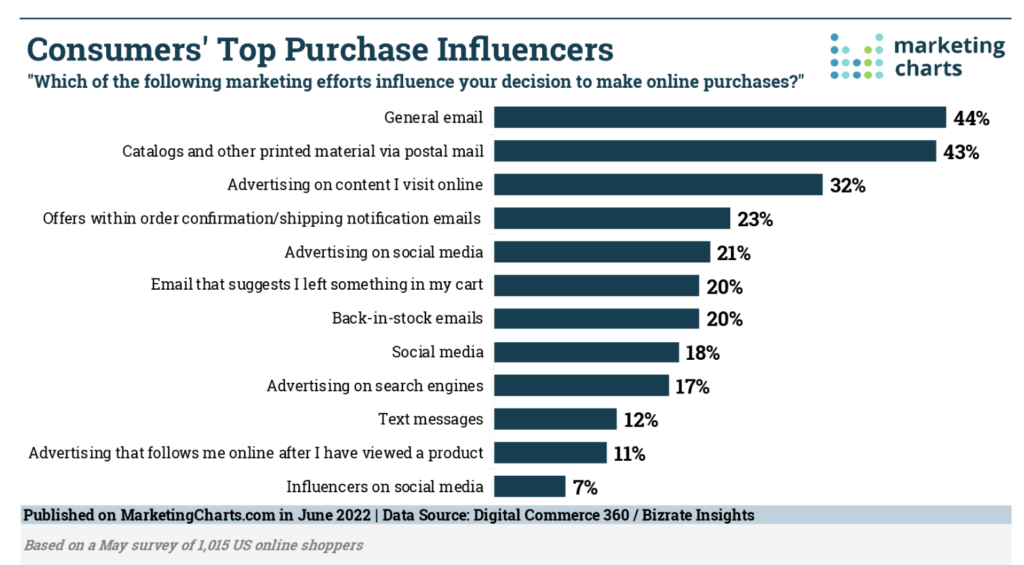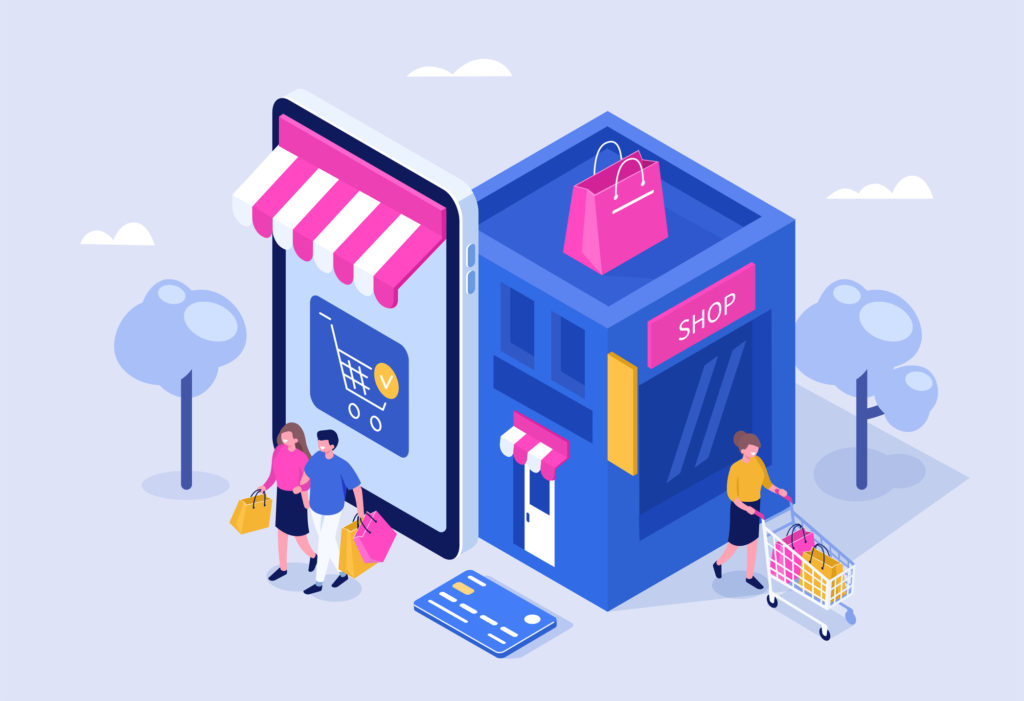Retail Marketing: Everything you Need to Know to Succeed
Even as the world around retail has changed, retail continues to be the cornerstone of commerce. Over the past 20 years, customers went from finding what they need in stores to having endless options online. Retail is no longer just about walking into a store to make a purchase.
For retail marketers, this means a whole new set of challenges. With digital ecommerce and social media, companies now have to think about creating a positive customer experience in a whole different space. Additionally, with new technologies, consumer trends, and tactics to contend with, building a retail marketing strategy is no easy feat.
To help you get better acquainted with the marketing side of retail and give you the tools to create a better strategy, we’ve put together an in-depth retail marketing guide. Learn all about what retail marketing is, how to adopt common marketing strategies, and why harnessing the power of today’s technology can take your retail marketing into the future.
What is retail marketing?
Retail marketing is a rather large umbrella that includes all the many activities retailers use to promote their products to customers and drive sales.
Retail marketing includes everything from the design, layout, and signage of a traditional brick-and-mortar retail business – both inside and outside the building – to the digital and ecommerce tactics used to drive visits to the company website.
Why is retail marketing so important?
The retail industry is an early indicator of overall economic growth or decline, as well as a highly competitive industry with several thriving sub-verticals. It offers marketers endless opportunities to connect with customers on a more emotional level than other industries. With the rise of ecommerce, brands have the opportunity to level-up the way they introduce products to their consumers, widening their reach and creating more impact – but only if they figure out how to do it right.
[Download our 2022 Retail Ecommerce Benchmark Report]
Successful retail marketing is the number one way to sharpen your brand’s competitive advantage in your specific market or markets. After all, having amazing products at incredible prices doesn’t really mean much if you don’t find the right ways to let your target customers know those products and prices exist.
Here are just a few advantages of retail marketing:
- Increase brand recognition. Brand recognition leads to increased visibility, as well as an increased likelihood of word-of-mouth promotion by your customers.
- Nurture customer lifetime value. Creating a strong brand through strong marketing is a key way to encourage repeat purchases and increase customer retention.
- Emotional bonds create customer loyalty. When retail brands really connect with their customers on an emotional level, those customers become (and remain) loyal.
- Teamwork makes the dream work. When you build retail marketing into your overall brand strategy, you create teams of individuals both on the ground and behind the scenes working to strengthen your customer connections on a daily basis.
Types of retail marketing
Retail marketing is a broad, overarching term that includes a number of different types of marketing all working together to create a strong brand that connects with its customers and sees the largest possible ROI. Types of retail marketing include:
In-store marketing
In-store marketing involves ads, displays, deals, or promotional activities that occur inside a physical location. Because customers are already in that location, these marketing efforts focus not on drawing attention to the brand but on aiding the customer shopping experience.
This can look like shelf tags announcing an item’s price drop, traffic patterns that expose customers to the most products possible, or employee training to address or assist customers in a standardized, brand-specific way.
Further examples of in-store marketing include:
-
- Promotions. Think “BOGO, or “buy one, get one free.”
-
- Samples. Because who doesn’t love free cake bites?
-
- Displays with sales or new price cuts. Picture those big, bright “clearance” signs you see at the end of each season.
-
- Live events or entertainment. “Retailtainment” is an opportunity to build a vibe in your store and around your brand.
Digital marketing
Digital marketing offers an almost endless array of opportunities to connect with customers, build brand recognition, and actually sell products. The channels and platforms you choose are extremely important for meeting your customers and prospects where they are online and staying ahead in the digital marketing landscape.

Examples of digital marketing include:
-
- Organic and paid social media marketing. Building your brand on social media platforms is a great way to connect, increase brand recognition, and drive sales. Both organic growth and paid marketing efforts can pay off.
-
- Website and SEO. Search-engine optimized websites aren’t just for online-only retail businesses. Brick-and-mortar stores can also benefit from having an informative and easy-to-navigate website.
-
- Email campaigns and email newsletters. Email has revolutionized retail marketing for every industry. With email campaigns and newsletters, you can send the ads you used to only be able to run in newspapers directly to every individual shopper’s inbox.
-
- SMS campaigns. Text messaging is one of the most immediate – and immediately profitable – ways to market your brand. SMS campaigns come with high open rates and the vast opportunity to provide value to customers who opt in to receiving SMS marketing messages.
Traditional marketing
Don’t make the mistake of assuming that, because the world has gone digital, the more traditional forms of marketing can be kicked to the curb. These methods have been in use for decades, and they’ve remained in use because they get results. Don’t be afraid to create a brand-tailored, customer-forward mix of in-store, digital, and traditional marketing strategies.
Examples of traditional marketing include:
-
- Direct mailers. Physical reminders of upcoming sales, promotions, or events help customers remember that they need to stop by your store. While emails or texts can be read and forgotten, a physical mailer will linger on their counter or kitchen table.
-
- Newspaper and magazine ads. Many people still read the paper every Sunday, and many people still pass the time in waiting rooms with a magazine. You never know when the right ad will find the right person, and print ads ensure your message will be around for that right person to find for quite a while.
-
- Billboard ads. These ads make a big, bold statement for everyone to see. What better way to drive traffic to your location than to advertise it to traffic already in motion?
-
- Event marketing at pop-ups and fairs. Good old-fashioned word of mouth is alive and well, thriving at pop-up events, fairs, festivals, and other gatherings. Setting up a table to display your products is a great idea, but don’t forget to focus on creating connections with all the prospective customers who stop by. Their good experience at the table will encourage them to come to your store later.
Common marketing strategies used by retailers
Successful retail marketing involves a lot more than a well-designed store or a well-curated catalog of products. Retail marketers need to adopt an array of strategies to find and nurture a strong customer base.

Common strategies used by retailers today include:
Understanding the customer journey
Brands that focus on building and maintaining relationships with their customers have a stronger chance of succeeding despite whatever competition they face. Why? Because meaningful connections encourage brand loyalty. People like to spend their money where they feel seen and valued.
Make sure you have an in-depth understanding of your customer lifecycle and all the stages shoppers experience with your brand. You can learn a good deal about your customers by paying close attention to their behavior at any given stage of their journey.
Segmentation is useful because it helps you divide a large group into smaller ones — but remember that what really makes a difference is understanding the motivations behind the actions of these smaller groups.
Once you understand the value of paying attention to your customer lifecycles, you can strengthen your outreach techniques, personalization strategies, customer retention, and revenue.
Focusing on personalization
Ecommerce Personalization is quickly becoming the new norm in marketing. Today’s customers demand individualized and relevant outreach based on their needs, wants, and interests. Treating customers as individuals, rather than lumping them all together, is the new standard approach to a successful retail marketing strategy. Customers want to feel like you know them, understand them, and are willing to listen.
Technological advances have led to the demand for increased personalization. Since shoppers are now able to bargain hunt online, they have access to products being sold around the world. Technology also serves marketers, allowing brands to go above and beyond with their marketing efforts.
Gone are the days when adding a customer’s name to an email was the height of personalization. Today’s retail marketers are upping their game and strengthening their personalization gaps with the help of artificial intelligence, machine learning, and omnichannel strategies.
Investing in a technology platform
The right technology platform allows marketers to engage with their customers across every channel and coordinate their traditional and digital marketing efforts with increased ease and speed. An AI-driven world works smarter, not harder.
Retail marketers that harness technology built specifically for the retail space realize enormous gains. Increased efficiency and deeper personalization yield increased revenue. But that’s just the bottom line. Beyond that lies the fact that wielding the right technology helps marketers connect with their customers and study their behavior, needs, and patterns.
As ever, a deeper understanding of who your customers are and what they need will help you create and invest in marketing strategies that actually serve the buyers that support your brand. Investing in the right-for-you technology platform will help you gain the insight and data necessary to connect with your customers on an emotional level.
Mastering predictive retail marketing
Predictive modeling isn’t new. Marketers have always used their current insights and data to predict customer lifetime value and lifecycle stages. What’s new today is the amount of data marketers have to sift through, and the technology available to make that sifting easier while yielding better, more accurate results.
With the right technology, you can predict the likelihood that your customer will take a given action when opening an email, or making a purchase within a certain period of time. You can then tailor your ads to further encourage or reward that action or purchase.
Done well, predictive marketing strategies can fold in neatly beside your other marketing strategies to increase customer retention and loyalty, and give you an even bigger ROI.
Using relevant marketing to connect with new shoppers
Customer expectation for personalization is high, and this includes a desire for relevant outreach efforts from brands. Use relevant outreach to expand your retail marketing efforts beyond the bland and impersonal, engaging with new customers in a way that really connects.
The more you know about your customers, the smarter your marketing will be when it comes to creating those relevant experiences for them. This is where all the data you gather through purchasing patterns, online behaviors, social media interactions, and more come into play.
Evaluating common paths to purchase online, for example, can help guide marketing campaigns toward customers completely new to your brand. Similarly, understanding the impact of traffic patterns on customers’ shopping experiences can help you create an in-store layout that is both efficient and pleasing to your new shoppers.
Tailoring marketing based on data
Your data is only as good as how you use it. The problem for a lot of brands is making sense of all the data available to them. Data that is often siloed around single areas of focus rather than integrated to create a larger picture of what is and isn’t working across the board.
Unifying and processing this data is the key to achieving better, smarter, faster personalization. This data includes:
-
- Customer identity
- Audience segmentation
- Product recommendations
- Ecommerce purchases
Each of these data sets can be sorted into three categories: Behaviors, customers, and products. Use these categories to unify your information and build successful, customer-focused strategies. Without this focus, any and all personalization efforts will fall well short of their potential.
Staying connected with customers
Connecting to your customers is a marathon, not a sprint. You’re not just blasting a sale announcement, after all. What you’re doing – or should be doing – is focusing on creating lasting connections that empower your customers and foster a sense of trust and connection with your brand.
Many marketers fall into the trap of focusing too much of their efforts on acquiring new customers while forgetting to direct an equal amount of energy toward building and maintaining relationships with their existing customers. And while new customers are always great, regular returning shoppers are the lifeblood of any retail business.
Use email marketing, mobile engagement, and social media platforms as ways to not only push sales and snag attention from new shoppers but to build out your brand and create a community for your customers. Cultivating connections builds long-term loyalty to your brand.
Examples of retail marketing
Talking about common retail marketing strategies is well and good, but what do these look like in action? Your efforts will, of course, be highly personalized to your customers and brand, but here are a few real-life examples to get you started.
Holiday lookbooks
The seasons change and so should your marketing campaigns. Holiday lookbooks and other seasonal catalogs are great immediate examples, and worth investing in. But cyclical marketing efforts can also look like holiday- or season-specific email designs, text messages, in-store signage, and more.
Sephora’s take on email marketing
Sephora has established clear, client-forward objectives for their email marketing campaigns, creating a program based on customer behavior rather than just pushing hot new products. This has led them to send fewer big, broad bursts of promotions and focus more on whether or not a message is relevant to particular customers. This testing and focus on personalization keeps Sephora agile, relevant, and successful.
Retail marketing trends you need to know
The world of retail marketing changes as fast as the rest of business. Keeping on top of tastes, trends, and technology isn’t easy, but it can make all the difference for your brand. Here are some current trends you need to have on your radar:
1. Omnichannel marketing
A seamless buying experience now depends on creating a smooth connection between websites, SMS campaigns, email marketing, and paid and social media. Engaging customers throughout every part of the buyer journey, across every channel, is the name of the game.
Walking hand-in-hand with omnichannel marketing is hyper-personalization, a trend that continues to be a must-have in any marketer’s toolbox. To make it work, harness your marketing data insights to focus on personalization across all your channels.
2. Social media ecommerce shopping
Many social media channels are integrating ecommerce shopping experiences onto their platforms. And companies like Instagram have taken advantage of the popularity of social media ecommerce by developing targeted ads, banners, and smart buttons to lure customers in.
All of which means your social media platforms are now more than just places to build and grow your community – they’re places you can actually sell as well.
3. Leveraging artificial intelligence
AI continues to be leveraged by retail brands to create increasing personalization, streamline the buyer journey, and strengthen the overall customer buying experience. Use AI to increase your brand’s targeting efficiency, create predictive marketing models, add chatbots to your website and ecommerce platforms, and more.
Develop your retail marketing plan with Bluecore
Building a retail marketing plan is essential for your brand to thrive, but building one on your own isn’t easy. Consumers are more connected, marketing-savvy, and empowered than ever — and both marketing and tech trends continue to evolve at an astounding rate.
The good news is you don’t have to do it alone. Bluecore is here to help you create a stellar retail marketing plan that takes your brand to the next level. Request your demo for our retail personalization technology today.



